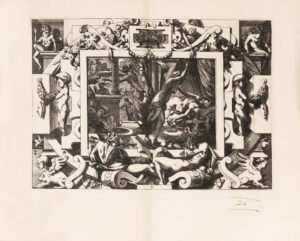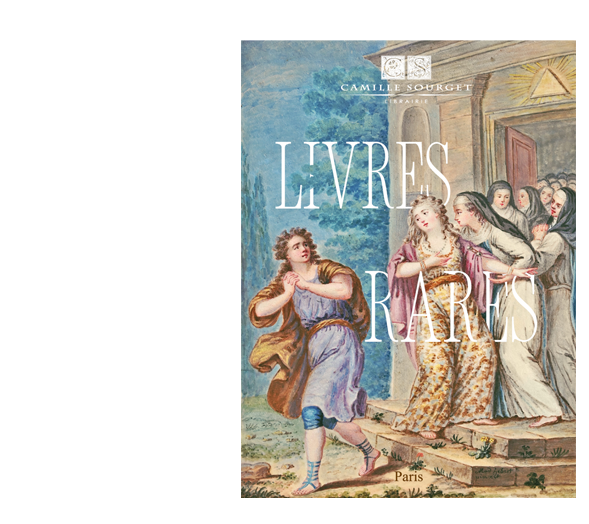Paris, n.n. [Jean de Mauregard], 1563.
Small folio [228 x 162 mm] of (4) folded oblong leaves: title, dedicatory epistle to King Charles IX signed by Jehan de Mauregard, and 4 pages of text in Latin by Jacques Gohory, followed by 25 engraved plates (out of 26, n° 19 is missing) in black on double-page, mounted on guards. A few marginal stains, handwritten inscriptions crossed out in the lower margin of 4 plates. The plates are not captioned unlike those of later issues.
Full brown calf, blind-stamped fillet around the covers, richly decorated ribbed spine, red and lemon morocco lettering-pieces, red edges, hinges, head of the spine and corners restored. Binding made around 1720.
First edition of the Latin issue, much rarer than the French one. Only one other copy of the Latin edition recorded on the market, the Wittock copy, with an interesting Renaissance binding, with 7 plates missing replaced in the 20th century by plates from a later edition and two plates with captions from the later edition, sold for 89250 pounds at Christie’s London on June 7, 2004, 17 years ago.
Precious and remarkable first issue before caption and numbering of the majority of the plates; the copy, close to Harvard College No. 519, having like this one 8 second issue plates with numbering but before captions: 13-18; 21 and 26.
« Title-page without ornamentation. The volume consists of four preliminary leaves and twenty-six engraved plates of the story of Jason and Medea, approximately 63/16 x 9″. The first is unsigned, the others are signed with the monogram “RB” of René Boyvin, and the last is signed in addition to the monogram, « Leonardus thiri. inuē. Renatus. .F » « In his dedication to Charles IX in French issue.
Jean de Mauregard writes, “I’en ay faict desseigner & pour-traire curieusement les figures par Leonard Tyri de Belges peintre excellent (comme l’œuvre descouure) & apres faict tailler en cuiure par René Boyuin natif d’Angers : ny espargnant ne les frais ne la sollicitude, en esperance de vous en faire present qui pourroit estre agreable : fust pour la lecture du livre ou par-auenture pour patron de quelque tapisserie à orner vn jour les sales de vos magnifiques palais . . . ou pour une peinture exquise à enrichir quelque galerie” (recto of 2nd prelim. leaf).
Leonard Thiry worked at Fontainebleau under Rosso and Primaticcio from 1536 to about 1542 (The Jason plates were attributed to both these masters when issued by later publishers.) Each scene measures about 3 3/8 x 5″, while the remainder of the copperplate comprises an elaborate border displaying a fantastic assortment of figures, putti, grotesques, birds, animals, and cartouches containing small scenes. It is this wealth of invention in the borders, sometimes eclipsing the scenes themselves, that makes this a major work in the Fontainebleau tradition. For a study of the Jason series, and the extent to which Mauregard’s plan of providing an artist’s model book was realized, see J.-J. Marquet de Vasselot, “La conquête de la toison d’or et les émailleurs limousins du XVIe siècle,” La revue de l’art ancien et moderne, vol. 34 (July-December 1913), p. [241], 253, [333}-345, reproductions. See also, Levron, Boyvin, p. 29-[34], P. 66-67, nos. 16-41, full series reprod. plates XIX-XLIV. Boyvin is one of the most influential figures in the early history of engraving in France. Robert Dumesnil (vol. 8, p. 36-44, n° 36-44) describes the copperplates in three states: first unnumbered, second with small numbers added at the top of the plate, and third – a much later impression – with the numbers removed. This copy contains a mixed set, the majority in the first state, but plates 13-18, 21 & 26 in the second, with the numbers. The fine, dark impression in this copy are particularly effective for the night scenes of n° 14, 18, and 23. The preliminary leaves are printed in roman and italic letter with three excellent grotesque initials.
Mauregard’s dedication is dated July 3rd and the privilege, July 14th of 1563. (Harvard, French Sixteenth, n°519).
One of the most precious and rare suites of the school of Fontainebleau, engraved on copper by René Boyvin from drawings by Léonard Thiry, one of the first painters called to Fontainebleau by king François Ier collaborator of Rosso and Primatice in the decoration of the palace.
Harvard, French 16th century books, II, n°519 ; Peter Ward Jackson, Some mainstreams and tributaries in European ornaments from 1500 to 1750, 1967, p. 10-13 ; Brun, Le livre français illustré de la Renaissance, p. 199 ; Brunet, II, 1648.
The work originates from a commission from Jean de Mauregard who, for the entertainment of Charles IX, had asked Gohory for this mythological account of the conquest of the Golden Fleece.
Mauregard, in his dedication, takes into account the dimension of “decorative repertoire” of the illustration and presents it to the king.
In 26 large format paintings (230 x 160 mm) leonard thiry excels in translating the multiple episodes of Jason’s legend, inserted in magnificent and very elaborated borders which place the work in the great tradition of the school of Fontainebleau.
“These prints were to be used as patterns for the great royal tapestries.” J. Gohory.
“Following the Italian wars, François Ier entirely devoted himself to the project of making industry, commerce and letters flourish. The celebrations given by the king, more elegant than sumptuous, offer the most brilliant images of chivalry. His almost universal curiosity pushed him to buy precious paintings and to propose them as models to French artists. He visited Primaticcio and Leonardo da Vinci in their studios and stimulated the emulation of French artists. He thus undertook the Louvre and had the castles of Fontainebleau, Chambord and Madrid built, surrounding himself with the greatest painters and sculptors of the time.”
The painter Leonardo Thiry was thus called upon by Francis I to exercise his talents at Fontainebleau where he worked from 1535 in close collaboration with Rosso and Primaticcio.
He participated in the decoration of the Francis I Gallery and then from 1537 to 1550 at the Porte Dorée.
The expense involved, the recruitment of artists, the effort of invention, the perfection of the ornaments and the originality of the result made the Francis I Gallery in Fontainebleau an essential event in the history of French art.
The decorative repertoire based on garlands of putti and fruit falls is a dizzying synthesis of Italian decoration adapted to French taste. The treatment and gaiety of Italian mannerism acclimatized in France make it an unprecedented creation defining for France, the school of Fontainebleau and the High Renaissance. André Chastel, L’Art français, II, 163-164.
Precious copy of the superb Latin issue, exceedingly rare, of exceptional contrast, preserved in its decorated calf binding from the 1720s, from A. Brölemann’s collection.

![[Livre de la conqueste de la Toison d’or] Hystoria Iasonis Thessaliae Principis de Colchica velleris aurei expeditione : cum figuris aere excusis, Earumque Expositione, versibus. Priscorum Poëtarum. Ab Jacobo Gohorio Parisiensi.](https://www.camillesourget.com/wp-content/uploads/2023/03/06bv1-bd-3nk0b.jpg)
![[Livre de la conqueste de la Toison d’or] Hystoria Iasonis Thessaliae Principis de Colchica velleris aurei expeditione : cum figuris aere excusis, Earumque Expositione, versibus. Priscorum Poëtarum. Ab Jacobo Gohorio Parisiensi. - Image 3](https://www.camillesourget.com/wp-content/uploads/2023/03/06cv1-bd-04EwY.jpg)
![[Livre de la conqueste de la Toison d’or] Hystoria Iasonis Thessaliae Principis de Colchica velleris aurei expeditione : cum figuris aere excusis, Earumque Expositione, versibus. Priscorum Poëtarum. Ab Jacobo Gohorio Parisiensi. - Image 4](https://www.camillesourget.com/wp-content/uploads/2023/03/thiry-planche-3-YLdV9-scaled.jpg)
![[Livre de la conqueste de la Toison d’or] Hystoria Iasonis Thessaliae Principis de Colchica velleris aurei expeditione : cum figuris aere excusis, Earumque Expositione, versibus. Priscorum Poëtarum. Ab Jacobo Gohorio Parisiensi. - Image 5](https://www.camillesourget.com/wp-content/uploads/2023/03/thiry-planche-4-83BQF.jpg)
![[Livre de la conqueste de la Toison d’or] Hystoria Iasonis Thessaliae Principis de Colchica velleris aurei expeditione : cum figuris aere excusis, Earumque Expositione, versibus. Priscorum Poëtarum. Ab Jacobo Gohorio Parisiensi. - Image 6](https://www.camillesourget.com/wp-content/uploads/2023/03/thiry-planche-5-RiURu.jpg)
![[Livre de la conqueste de la Toison d’or] Hystoria Iasonis Thessaliae Principis de Colchica velleris aurei expeditione : cum figuris aere excusis, Earumque Expositione, versibus. Priscorum Poëtarum. Ab Jacobo Gohorio Parisiensi. - Image 7](https://www.camillesourget.com/wp-content/uploads/2023/03/thiry-titre-twjvJ.jpg)
![[Livre de la conqueste de la Toison d’or] Hystoria Iasonis Thessaliae Principis de Colchica velleris aurei expeditione : cum figuris aere excusis, Earumque Expositione, versibus. Priscorum Poëtarum. Ab Jacobo Gohorio Parisiensi. - Image 8](https://www.camillesourget.com/wp-content/uploads/2023/03/06av2-bd-pU3uC.jpg)
